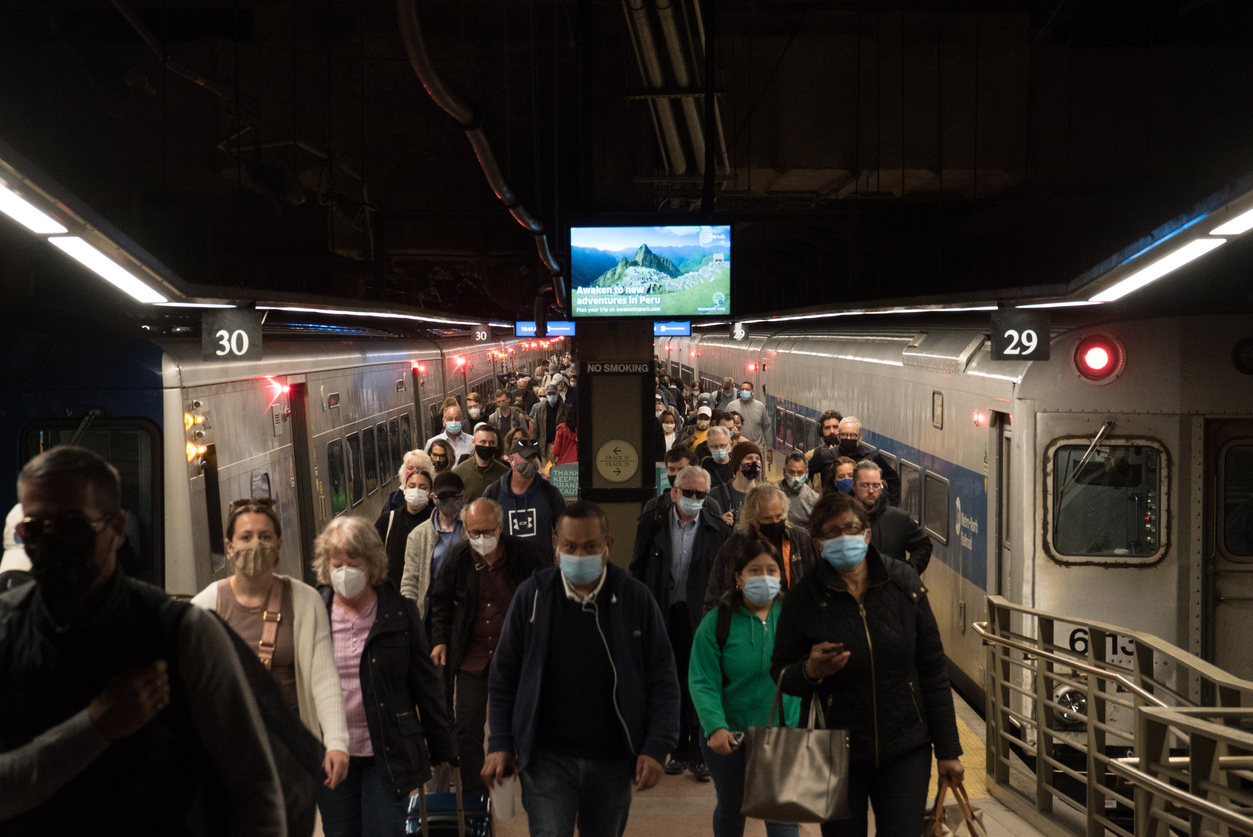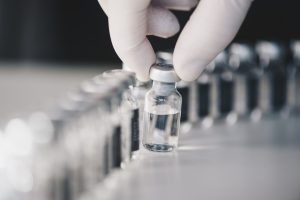Study suggests continued face mask use for at least two weeks after the U.S. population is at least 70 percent fully vaccinated would more than pay for itself
In recent weeks, many locations in the U.S. have been lifting indoor face mask requirements, despite less than 70 percent of the population being fully vaccinated against Covid-19 and less than 45 percent having received the booster. A new study published March 8 in The Lancet Public Health by CUNY SPH Professor Bruce Y. Lee and colleagues suggests that consistently maintaining face mask use until, and even two to 10 weeks beyond, reaching various vaccination coverage thresholds (e.g., 70 to 90 percent of people fully vaccinated) could not only prevent a substantial number of cases, hospitalizations, and deaths but also end up saving businesses, the health care system, insurance companies, taxpayers, and others money.
Results from the study’s computer simulation model of the entire U.S. suggest that when the reproductive number of the virus (e.g., how contagious and infectious the variant is) is five, corresponding to the delta variant, and 80 percent of the population is fully vaccinated by May 1, maintaining face mask use until then could save a total of $2.9 billion in direct medical costs, which would benefit the healthcare system, insurance companies, and anyone else paying for healthcare. It could save a total of $20.1 billion in productivity losses, which would benefit employers and taxpayers. If the same coverage (e.g., 80 percent) is reached by July 1, maintaining face masks use until then could save a total of $3.3 billion in direct medical costs and $23.4 billion in productivity losses. All of this suggests that it would be worthwhile for employers, governments, and insurance companies to invest into providing face masks and maintaining their use until two to 10 weeks after different target vaccination coverages have been reached.
The study was led by the Public Health Informatics, Computational, and Operations Research (PHICOR) team at the City University of New York Graduate School of Public Health and Health Policy (CUNY SPH) along with a team from the National School of Tropical Medicine at Baylor College of Medicine. The team developed a computer simulation model of the entire U.S. that simulated the spread of Covid-19 coronavirus, subsequent outcomes of infection (e.g., symptoms, hospitalizations), vaccination, face mask use at the levels seen in the U.S. from March-July 2020, and the associated costs along the way.
“The messaging about face mask use has been inconsistent throughout the pandemic as there has been back and forth about the use of face masks,” says Dr. Lee, executive director of PHICOR and the study’s senior author. “There has been a tendency to focus on one intervention at a time. First there was a focus on social distancing and then the focus turned to face mask wearing. Then, attention turned towards the Covid-19 vaccines once they came out. Instead, as long as the pandemic is continuing, there’s a need to consistently layer multiple interventions on top of each other since each complement and enhance each other.”
The study suggests there are benefits to maintaining face mask use two to 10 weeks beyond achieving target coverage levels (e.g., 70 to 90 percent fully vaccinated). The duration beyond achieving vaccination coverages was greater in the winter (up to 10 weeks) than the summer (at least two weeks). The study found that continuing face mask use for one more month beyond achieving 70 percent coverage by March 1 provided additional value, averting an additional $1.5 billion in societal costs, $148.6 million in direct medical costs, $3.9 billion in productivity losses and 856,000 cases compared to if masks were not maintained for the additional month. Thus, the study provided evidence that Americans will not need to wear face masks forever.
Face masks could offer even greater benefits with more infectious variants such omicron and its subvariant BA.2. For example, results from the model suggest that when the reproductive number is 10, corresponding to the omicron variant, maintaining face masks would avert $49.5 billion in societal costs (e.g., direct medical costs, productivity losses, face mask costs), $5.2 billion in direct medical costs, $48.8 billion in productivity losses and 17.9 million cases compared to no mask use if 70 percent of the U.S. was fully vaccinated by March 1.
“Vaccines save lives but alone are not enough to get our society to a point where we can safely be free of Covid-19 requirements like face mask use yet,” said Dr. Peter Hotez, professor and dean of the National School of Tropical Medicine at Baylor College of Medicine and co-author of the study.
Of note, the study looked at maintaining the level of face mask use that was seen in the U.S. in March to July 2020 when many medical-grade face masks were not as readily available to the general public. Further increasing face mask use or using more effective masks such as N95 respirators could further increase the cost savings. For example, scenarios revealed that increasing face mask use by 10 percent above the levels seen in March to July 2020 could increase the cost savings and cases, hospitalizations and deaths averted by up to 20 percent.
Moreover, anything that further increases Covid-19 coronavirus’ infectiousness (e.g., variants and subvariants), decreases vaccine effectiveness (e.g., waning immunity, lack of boosters, emerging variants), or increases social interactions only increased face masks’ value. The study’s results highlight the importance and value of implementing multilayered interventions such as continuing to use face masks while vaccinating and social distancing.
“The study’s results suggest that it could be economically worthwhile for businesses to provide and encourage face mask use,” said study co-author Dr. Maria Elena Bottazzi, associate dean of the National School of Tropical Medicine at Baylor College of Medicine. “The results also provide targets to aim for in which we can drop the mask requirements indoors.”
“Maintaining face mask use before and after achieving different COVID-19 vaccination coverage levels: a modelling study” was written by Sarah M. Bartsch, Kelly J. O’Shea, Kevin L. Chin, Ulrich Strych, Marie C. Ferguson, Maria Elena Bottazzi, Patrick T. Wedlock, Sarah N. Cox, Sheryl S. Siegmund, Peter J. Hotez, and Bruce Y. Lee.
This work was supported by the Agency for Healthcare Research and Quality (AHRQ) via grant 1R01HS028165-01, the National Institute of General Medical Sciences (NIGMS) as part of the Models of Infectious Disease Agent Study network under grants R01GM127512 and 3R01GM127512-01A1S1, the National Science Foundation (NSF) proposal number 2054858, the National Center for Advancing Translational Sciences (NCATS) of the National Institutes of Health via award number U54TR004279, and the City University of New York (CUNY) in support of the Pandemic Response Institute (PRI). Statements in the manuscript do not necessarily represent the official views of, or imply endorsement by, the National Institutes of Health, AHRQ, the United States Department of Health and Human Services (HHS), the CUNY, or the PRI.
About CUNY SPH
The CUNY Graduate School of Public Health and Health Policy is committed to teaching, research, and service that creates a healthier New York City and helps promote equitable, efficient, and evidence-based solutions to pressing health problems facing cities around the world.
About PHICOR
Since 2007, Public Health Informatics, Computational, and Operations Research (PHICOR) has been developing computational methods, models, and tools to help decision makers better understand and address complex systems in health and public health. Follow @PHICORTeam for updates.
About BCM
Baylor College of Medicine (www.bcm.edu) in Houston is recognized as a health sciences university and is known for excellence in education, research and patient care. Located in the Texas Medical Center, Baylor has affiliations with seven teaching hospitals and jointly owns and operates Baylor St. Luke’s Medical Center, part of CHI St. Luke’s Health. Follow Baylor College of Medicine on Facebook (http://www.facebook.com/BaylorCollegeOfMedicine) and Twitter (http://twitter.com/BCMHouston).
# # #




